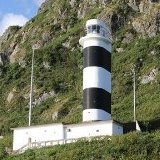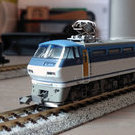Search the Community
Showing results for tags 't-trak'.
-
Hi folks! 3 weeks ago I realized one of my dreams with my longtime partner. Trainsetter Ulli Liedtke & Natascha Drews GbR in Germany is now at the model train market. We will produce selected products for the N (1: 150 & 1: 160) and Z (1: 220) gauge in the future. Our first product, which we would like to introduce to you, is available soon in July 2019! The starter set "Hänschen" contains a catenary for the track system Kato Unitrack and Tomix Finetrack in gauge N. 2 pieces long wires for 280mm and 4 pieces short wires for 140mm mast spacing in 0.25mm stainless steel. Of course, the wires are thus suitable for curves, which can be tailored to suit his needs. "Hänschen" is only suitable for the indicated overhead line operation, which means that the pantograph must not touch the wire. Unfortunately we are not ready yet with a website! We are happy to answer your questions via trainsetter-gbr (at) gmx.net or on Facebook and Twitter. Whether in English or German, we will answer your questions. For mid-July, distribution via dealers is planned. Yours sincerely Ulli Liedtke Trainsetter Ulli Liedtke & Natascha Drews GbR email: trainsetter-gbr ( at ) gmx.net Flyer 2019.pdf
- 45 replies
-
- 12
-

-
- overheadwires
- kato
-
(and 2 more)
Tagged with:
-
Hi all, After finding some 6mm MDF in the garage, I've decided to give T-Trak a go. I've got 3/4 of the way through putting two "standard" 308mm x 300mm modules together. The photos show the results: Poorly assembled, constructed etc, but hey it's a learning curve!
-
Here are a few modules I have built so far. They are very much generic in terms of sfenery as I still haven't decided what location and time I want to represent. Although now I plan to built another bunch of modules for my Japanese stock. The topic is called russian ttrak as the modules are made to standards slightly modified by some russian enthusiast. As far as I understand major differences are the holes that allow to bolt them together and the requirements for a bus wiring and use of specific connectors. The next will still be for this section and although these modules still require lots of smaler details I plan to switch to japanes landscapes
-
Hi everyone! Wanted to pick your brains and get some ideas of what I could do with this curved piece of T-trak. I've been looking on line but mainly just found some really nice straight tracks :/ Thanks in advance - Mauricio
-
Hi everyone, This thread is going to be dedicated the build of a T-trak module that is based loosely around a small rural Japanese station. It may not be overly prototypical, but it will be very Japanese. I Also aim to include a steam loco shed and maintenance yard, as well as a fair bit of scenery. Quite a few months ago I was at my local train shop (Austral model craft in Mt Gravatt) and saw the kato rural platform kit and was thinking about how to incorporate that into a layout. I purchased that kit and an extension kit a few weeks ago. I originally saw the Ipswich model train club T-trak display at a show last May (photos below) and thought that it was quite cool, and was really interesting from a space perspective - It appealed to me as I don’t have a place to leave a large layout set up all the time, so something modular made sense to me. When I eventually have multiple modules, they can be stored on a shelf, and get setup on some plastic tables when i want to run some trains. I Don't have a space I can leave a layout setup, so this seems like a good fit for me. I started putting together the platforms, but didn't get many photos of it. They were a bit fiddly and getting the correct sides to line up wasn't easy. I spent about 3 hours just cutting the pieces out of the sprue. More to come, this is just the start, I'm just a little bit behind on the documentation of the process. Heres a closeup of the inspiration on the box.
- 14 replies
-
- 12
-

-
Hey everyone! So, I'm relatively new to the forums, but I have made a few posts. I'm having a blast with my home layout, but I was lucky enough to find a local N-Scale club full of great guys. We do two types of train shows, our N-Trak modules and just this year the club has started breaking into T-Trak modules. Since I'm relatively new to the hobby overall, I knew I didn't have enough skill or space for a huge N-Trak module, so getting into T-Trak was the perfect start. So, I'd like to present to you, my first ever module, a Japanese Shrine! As you can see, I also have my awesome limited edition Kato pocket line train. I think it fits in perfectly with the module! So, it's not perfect, but I'm super proud of how it turned out. This was my first time doing any sort of scenery on my own. I think it's such a fun piece and even if it won't fit in with the other modules at all, I think it will be even better because it will stand out! Let me know what you think! I'll be sure to post future ones here as well.
-
This is going to be my first attempt at a single module - Up until now I have only worked with doubles. Obviously part of the concept of T-Trak is to work with small modules rather than whole layouts that take up quite a lot of space. I’m not actually sure that I want to have single modules, so before I buy some from the guy who makes them for me, I decided to cut out some cardboard and put down two single tracks for the straight through, and tried to work out the best solution for the engine shed. You can see that the cardboard isn't super accurate, and makes it hard to line up with with other modules, but its just a mockup. I spent some time trying to work out the track arrangement, but came to the conclusion that the 2 engine shed tracks will line up with my rural module on the extra 2 tracks, which you can see the progress on in this thread: I'm planning on using the the kato ash pit track, which lines up with the base of the shed really well - it also has flat edges that should be easier to glue together. This is also the first time that I have used bumpers on a module, as this will be the end of the line for tracks 3&4. I assembled the engine shed after a long day at work, and don't believe that I took any photos of the shed as I put it back together.... However, I ordered from Banzai hobby, and they sent me 2, so there will be more photos to come of that shed and its components... Thats it for now...
-
To save my sanity as we wait to sell the house and have a huge international move I've decided to build a t-trak module. I've finally made a start and am ready to share a little. :) I've been poring over google maps to look at typical urban residential areas and have come up with this layout. I've about to order a bunch of detail parts, there will be a level crossing at the end of the street and small gardens / greenery between buildings. I've also ordered some white nail tape to try to make some decent street markings.
-
Hello all, This year the JNMA will be held again, but at a different location this time. The previous JNMA were held in Hamamatsuchō, but this year they have moved to Asakusa, in the Taitōkan, almost next to Sensōji. http://www.jnma.com/ The event will be held de 3rd of July, so for those visiting Japan then, please don't hesitate to drop by! Lots of extreme bargains to be had and chats to be made! I will be there from before the beginning to beyond the end, as I'll be participating for the first time in one of the 25mm T-Trak meetings. Yes, I'll be specifying T-Trak meetings from now on in 25mm and 33mm categories, as the 33mm will become a thing here soon. There will be a few 33mm modules there as well, but the mainstay will still be 25mm (like mine). Anyway, for those who don't know, the JNMA is a 2nd hand model train market with small manufacturers also selling their products. Some rare and special things can be found here at quite reasonable, to bottom prices. See you there!
-
Hello all, I see works of our Hungarian members got shared on a new Facebook group page called "T-Trak Tokyo Project": https://www.facebook.com/groups/1013302152090795/ This is a group that has just started off and wants to popularise the 33mm "Alternate Spacing" module standards for a broader public, other than just tram enthusiasts. Here they take a look at what is going on abroad with T-Trak and concluded that 33mm is by far the most popular standard, as opposed to the declining popularity of 25mm in Japan. It also seems that this project will be endorsed by Kato, as the first lecture on this project will be held on the May the 29th in Kato Hobby Centre Tokyo. One of their goals will be to create the largest T-Trak layout in the world in 2020, during the Olympic year. Somehow, I feel this can become a great success, as they also want to incorporate the popular MoRaCo and the JAM. Personally, I've gotten very interested in this project, as it's a great attempt at uniting T-Trak around the world. Whereas the alternative 33mm standard has maintained its status quo around the world, the original 25mm standard has declined in popularity in Japan. Hence, I'll try to attend this meeting to keep up to date with the developments.
-
Sooo... As many of you may know, there are plans to create some sort of Dutch Japanese T-Trak club, but apart from a standards guide and some try-outs by Toni and Martijn not much has been achieved yet except for postponing. I personally also came up with several ideas for prospective modules, but I never liked them enough to put them into reality. But more than that I couldn't decide what exactly I wanted to model. A double track suburban mainline; a single-track rural line; JR East; JR Shikoku; something completely different; etc. etc. Eventually I narrowed down my modelling interest to the Keihan Ōtsu Lines and JR Shikoku, but decided to go with the Ōtsu Lines for my T-Trak modules because it fits better in the limited space of the modules and the rolling stock is cheaper. :P I still want to make a layout for my JR trains one day, but that's for another time. If you think of the Keihan Ōtsu Lines there's one thing that will immediately pop-up in your mind: the street running section. The street-running section is located south and west of Hamaōtsu Station where the Keishin Line and the Ishiyama-Sakamoto Line join. I first wanted to incorporate Hamaōtsu Station in the modules including the famous intersection, but while it's a very interesting station, it's way too big for a small T-Trak module and just not really to my taste scenery-wise. I also wanted to replicate the siding east of Hamaōtsu Station (you need some sidings anyway and that way it would be prototypical as well), but that made the station+intersection+sidings way too long and resulted in spacing problems between the Unitram switch needed for the intersection and the normal Unitrack switches for the siding. All in all an interesting challenge, but it just wasn't really what I was looking for. Shinomiya Station Looking for a way to put a station, sidings and interesting scenery in a small space, I came across Shinomiya Station located on the Keishin Line and Ōmijingūmae Station on the Ishiyama-Sakamoto Line. Ōmijingūmae Station has some sidings and a maintenance facility near the station, but Shinomiya Station has sidings adjacent to the station platforms which means that it's possible to put everything together in a very small space. Shinomiya station also has some nicer scenery with a river crossing the tracks just west of the station. Because planning can't hurt I played a bit with Anyrail which resulted in this: (Module size: 1240 x 310 mm) The lengths of the platforms have to be at least 43 cm to provide space for the 4-car Keihan 800 series. Here you can see how it would look like with trains in the station: (blue = 16m long Keihan 800 series; green = 2-car 15m Keihan train; red = standard 20m 3-car EMU; yellow = maintenance vehicle) Apart from that this layout provides three platform tracks and sidings, it's also possible to change tracks using the middle platform track without causing a short circuit because of the power routing of the Unitrack turnouts and thus also shunting a train from the sidings to the outer track (below in the picture) should also be possible. The sidings are not really long enough to store an 800 series EMU, but as you can see with some creativity everything will fit. I could make the sidings longer by making them parallel to the main tracks, but that makes the view a bit boring. The main disadvantage of this plan is that the station will be four modules long with no way of making shorter modules because of how the tracks are arranged. 1240 mm is quite a length... There's one other problem: I don't really know which platform to use for the island platform. The distance between the centers of the tracks is 49.5mm, which means that Kato platforms which are made for 66mm spacing will not work. Tomytec/Tomix have some platforms with 25mm width, but I fear that those will be too narrow leaving ugly gaps between the train and the platform. Greenmax' city island platform is also too wide (40mm), but Greenmax' one-sided city platform could work being 30mm wide. I'm thinkin of kit-bashing the Greenmax side platform base with some roofs, but first I will have to measure everything. Street-running is still something I want to have somewhere of course, but I'll probably make a separate module or two for that.
-
Over the last few months I've been looking into building T-Trak modules as a way of getting some of my layout ideas into reality without having to build a single large layout. This has also coincided with research into laser-cutting services and I figured that it would be fairly easy to combine the two. As such, I'm pleased to present my prototype laser-cut T-Trak module. It's not perfect as I made a small miscalculation in the measurements of the front panel but it holds together well and is surprisingly rigid. I designed the pieces to slot together using tabs and slots; the tabs on the top piece match up with the T-Trak alternate spacing standard and Kato trackbed width to act as a guide for laying track. I had it laser-cut by Razorlab (UK) and the process is almost as simple as designing the pieces in a vector graphics program (I use Inkscape, free software), uploading it to Razorlab's website and getting an instant quote. It took about 5 days from order to arriving on the doorstep. The material is 3mm plywood, which is the thickest Razorlab have. I was a little concerned that it might not be thick enough but it seems to be more than suffice for this size of module. Larger modules may need cross-bracing and module size will be limited by Razorlab's maximum material size (790 x 384 mm). For me, the benefit of laser-cutting is that I don't need to invest in tools that I would otherwise never use and that it is much easier to achieve high levels of precision - I know from experience woodworking is not my specialty. Now that I've got a good prototype, I'm looking forward to decorating it with scenery and designing some more adventurous modules to make progress towards those layout ideas I've been itching to create!


















.png.2729f2b5b62f8ae0f10c1a5d9db0b64b.thumb.png.d491ffbb553041717238132878e58212.png)












